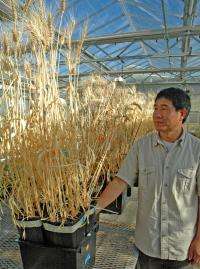AgriLife Research study seeks to pinpoint wheat drought-tolerance mechanisms

Maybe it’s in the shoot, maybe the root. Texas AgriLife Research scientists are on a quest to find where different wheat varieties popular in the High Plains get their drought tolerance.
Dr. Shuyu Liu, AgriLife Research small grains geneticist in Amarillo, is working with a group of scientists on an Ogallala Aquifer Program-funded project to identify key genetic regulators of drought tolerance.
“We are trying to understand the drought-tolerant mechanisms in wheat varieties,” Liu said. “In this study, we are looking at three widely planted varieties in the High Plains, TAM 111, TAM 112 and TAM 304.
“Based on breeders’ observation, they found that TAM 111 is very good at both irrigated and dryland,” he said. “TAM 112 is much better under prolonged dryland conditions, such as 2011. TAM 304 is very good under irrigated conditions, but not under dryland.”
Dr. Srirama Krishna Reddy, AgriLife Research post-doctorate research associate in Amarillo, works in the lab to conduct gene expression analysis on the different wheat varieties.
Breeders’ observations from the field and the physiological traits collected in the last few years show these three cultivars have different responses to water stress; however, the basis of their adaptation remains unknown, he said.
Determining the mechanisms of adaptation to drought conditions is very important, Liu said, because in 2011 alone, drought stress resulted in the loss of more than 240 million bushels of winter wheat with a cost of about $1.33 billion in the Southern Great Plains.
“We conducted this experiment in the greenhouse to understand how these three varieties respond to water differently and at different stages,” he said. “Currently, we are at the harvesting stage. We have already collected samples from different growth stages for laboratory analysis and now we will collect samples to estimate grain yield and shoot and root biomass on each of these three varieties. In the lab, we will do gene-expression studies to understand what kind of gene is behind each of these varieties controlling their different drought–tolerance mechanisms.”
Dr. Srirama Krishna Reddy, AgriLife Research post-doctorate research associate in Amarillo, said, “We want to understand what mechanisms exist in the plant – whether in the root system or the shoot system. Several physiological and molecular tools will be used to discover the mechanisms behind the drought adaptation.”
This wheat study was planted in late November and includes the two drought-tolerant varieties and one drought-susceptible variety, Krishna Reddy said.
“We started this study with three different blocks,” he said. “Leaf samples from two other blocks were harvested for gene expression analysis using microarray technology. With this last block, we are going to look at the grain yield and the harvest index under prolonged drought conditions and irrigated conditions.”
Liu said at the same time they have been conducting this greenhouse experiment, all these three varieties have been growing in the field and many data will be collected by the AgriLife Research stress physiology and breeding groups at Amarillo, such as yield and its components and canopy temperature.
“At the end, we will combine the greenhouse data, field data and lab data together to figure out what the difference is for the drought-tolerant mechanism among these three varieties,” he said.
Provided by Texas A&M AgriLife




















